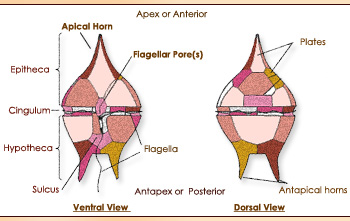Dinoflagellates
|
37 dinoflagellate species were recorded to cause red tide in Hong Kong. Dinoflagellates (Dinophyceae) are microscopic unicellular, free swimming organisms with two flagella. The transverse flagellum may be contained in a groove-like structure around the equator of the organism, providing forward motion and spin while the longitudinal flagellum trailing behind providing little propulsive force, mainly acting as a rudder. Dinoflagellate are often divided to 1) armoured dinoflagellate (possessing a theca) and 2) naked dinoflagellate (without a theca).
Most species are basically round in shape and some species can form chains e.g. Dinophysis spp. and Tripos furca. Some dinoflagellates are both autotrophic (i.e. can utilize inorganic sources of carbon, nitrogen etc) and heterotrophic (i.e. able to utilize organic sources of carbon, nitrogen etc). Dinoflagellates are commonly between 5–2000 microns in length/diameter. The majority of dinoflagellate species is marine, but they are also found in freshwater lakes, rivers and swamps/marshes. The following figure shows the structure of dinoflagellate.
|
||||
|
||||
